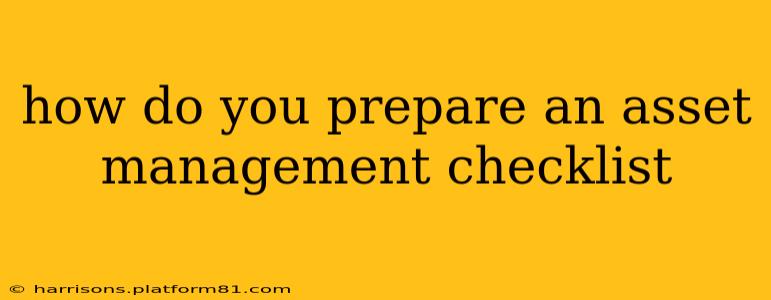Effective asset management is crucial for any organization, regardless of size or industry. A well-structured checklist ensures consistent procedures, minimizes risks, and maximizes the lifespan and value of your assets. This guide details how to prepare a comprehensive asset management checklist tailored to your specific needs.
What is an Asset Management Checklist?
An asset management checklist is a detailed document outlining the steps involved in managing assets throughout their lifecycle. This includes acquisition, maintenance, utilization, and disposal. It provides a structured approach, ensuring no crucial steps are missed and promoting consistency across the organization.
Creating Your Asset Management Checklist: A Step-by-Step Guide
The process of creating your checklist is iterative and should be reviewed and updated regularly. Here's a structured approach:
1. Define Your Assets: What Needs Managing?
This is the foundational step. Identify all assets requiring management. This isn't limited to physical assets like equipment and vehicles; it also includes:
- Tangible Assets: Machinery, equipment, vehicles, buildings, land, furniture, computers, software licenses.
- Intangible Assets: Intellectual property (patents, copyrights), software, brand names, trademarks.
- Financial Assets: Investments, cash reserves.
Pro Tip: Categorize your assets for easier tracking and reporting. Use a system that makes sense for your organization, perhaps by department, location, or asset type.
2. Asset Acquisition & Onboarding: The Beginning
This section of your checklist covers the procedures for acquiring new assets. Include steps like:
- Budget Approval: Formal approval process for asset purchases.
- Supplier Selection: Criteria for choosing vendors.
- Receiving & Inspection: Procedures for inspecting new assets upon arrival.
- Documentation: Detailed records of asset purchase, including cost, vendor, and warranty information.
- Tagging & Identification: Assigning unique identifiers (barcodes, RFID tags) for easy tracking.
- Data Entry: Inputting asset information into your asset management system.
3. Ongoing Maintenance & Operations: Keeping Assets Running
This is a critical part of your checklist and will likely be the most extensive section. It should cover:
- Preventative Maintenance: Regular scheduled maintenance tasks to prevent breakdowns (e.g., oil changes, software updates). Schedule specific intervals and assign responsibility.
- Corrective Maintenance: Procedures for addressing unexpected breakdowns or malfunctions. Include steps for reporting issues, troubleshooting, and repair.
- Calibration & Testing: Regular calibration of instruments and testing of equipment to ensure accuracy.
- Inspection & Audits: Regular inspections to identify potential issues and assess asset condition.
4. Asset Utilization & Performance Tracking: Maximizing Value
This section focuses on tracking asset usage and performance. Include:
- Usage Tracking: Monitoring asset utilization rates to identify underutilized or overused assets.
- Performance Monitoring: Tracking key performance indicators (KPIs) relevant to each asset type.
- Reporting & Analysis: Regular reports summarizing asset performance and utilization.
5. Asset Decommissioning & Disposal: The End of Life
This final stage covers the end of an asset's lifecycle. Include:
- Decommissioning Procedures: Steps for safely removing assets from service.
- Disposal Methods: Procedures for disposing of assets responsibly and in compliance with regulations (recycling, resale, etc.).
- Record Keeping: Documentation of asset disposal, including date, method, and any proceeds from resale.
6. Regular Review & Updates: Adapting to Change
Your checklist is a living document. Review and update it regularly to reflect changes in your organization, new assets, or evolving regulations.
Addressing Frequently Asked Questions (FAQs)
What software can I use for asset management? Numerous software solutions cater to asset management needs, ranging from simple spreadsheet programs to comprehensive enterprise asset management (EAM) systems. The best choice depends on your organization's size, complexity, and budget.
How often should I review my asset management checklist? Aim for at least an annual review, but more frequent updates might be necessary based on changes in your asset portfolio or regulatory requirements.
How can I ensure compliance with regulations? Your checklist should incorporate all relevant industry regulations and standards. Stay updated on changes in legislation.
By meticulously following these steps and consistently using your asset management checklist, you’ll streamline your processes, minimize risks, and ensure the optimal performance and longevity of your valuable assets. Remember, the key to success lies in adapting this framework to your specific organizational context.
